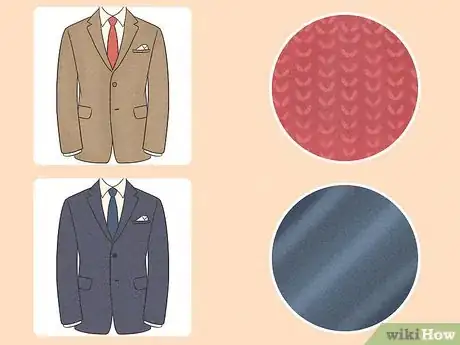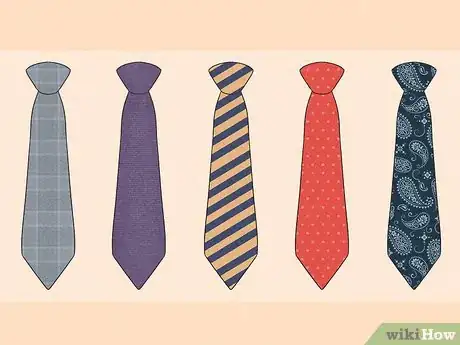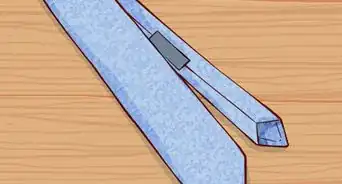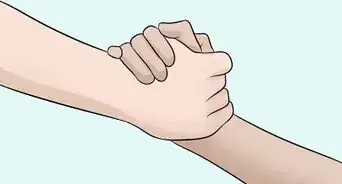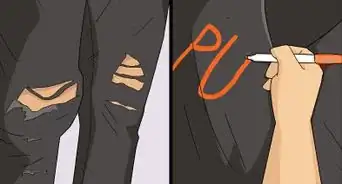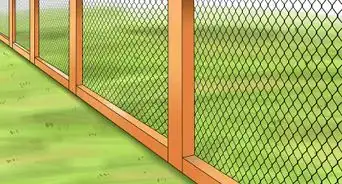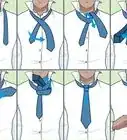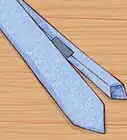X
This article was co-authored by Tavia Sharp. Tavia Sharp is a Certified Image Consultant and the Founder of Styled Sharp. With more than 20 years of corporate fashion experience, she specializes in helping others build a brand image through personal style, appearance, behavior, communication, and digital presence. Tavia holds a BS in Fashion and Apparel Design from The University of Delaware and has her Corporate Consultant Certification from The Academy of Image Mastery.
There are 7 references cited in this article, which can be found at the bottom of the page.
This article has been viewed 279,694 times.
Steps
Method 1
Method 1 of 2:
Choosing a Tie
-
1Understand the various parts of the tie. Knowing a quality tie when you spot it, is dependent on knowing what you should look for. The following elements of the tie are things to check:[2]
- Look at the lining of the tie. The purpose of the lining is to make tying the tie easier and to prevent it from wrinkling. The lining should be made from 100 percent wool. The more gold bars on the lining, the heavier the lining.
- Feel and look at the fabric of the tie. If you're after silk (the ideal tie fabric), make sure it is by feeling it. Silk is smooth; other fabrics mimicking silk tend to feel brittle. A quality tie will be made from three pieces of fabric, while a cheaper one will be made from only two.
- Check for hand rolling: A hand-rolled and hand-stitched hem keeps a much better shape than a machine-made one.
- Look for the slip stitch. This can be pulled to gather the tie together. This helps to maintain the shape of the tie.
- Note the bar tack. This is the piece that supplements the slip stitch and keeps the two ends of the tie from separating.
-
2Size it up. Pick a tie that hits the top of your belt buckle and measures between 2 ¼ and 4 inches (5.5 cm - 10 cm) wide.
- For a classic look, choose a width that corresponds to the width of your jacket’s lapel.
- A tie should not be too loose or too tight; both ends of the spectrum are incredibly uncomfortable, so be sure it fits well around your neck.
Advertisement -
3Remember textures. Wear wool ties with tweed or heavyweight jackets, and silk ties with business suits. For a deeper color quality on silk ties, make sure they’re woven, rather than screened.
-
4Look in the mirror. Frame your face. If you have dark hair and a dark complexion, go with a bright tie; if you’re fair, choose a darker tie. If your hair and skin tone contrast, wear a tie that contrasts with your skin tone.
Advertisement
Method 2
Method 2 of 2:
Wearing a Tie
-
1Match colors. When it comes to colors, there are literally thousands of colors available in men's bow ties, striped ties and paisley ties, more than you can imagine. First of all, you have to decide which color of tie will go with your overall attire and the occasion.[3] Select a tie that has the colors of your suit and shirt as well as at least one other color to provide an accent. For formal occasions, choose a solid colored tie that’s darker than your shirt.
- A solid tie is the most versatile of all neckties because it is appropriate with everything.
- A dark tie is appropriate for business wear. Pairing it with a khaki or blue shirt evokes military uniform authority.[4]
- A black tie goes with everything and is suitable for all occasions from funerals to work. It's also ideal for hiding stains.
- Younger men, or men living in warmer climates, tend to prefer colorful ties (and shirts).[5]
- Look for a tie that goes well with your dress shirt. This tie will be kept for best. Make sure it has a nice balance or color to it so that it looks good.
-
2Match patterns. As with the colors, there are different patterns too available in the various online tie stores. Always determine the occasion before buying a patterned tie; since wedding is a formal affair, a formal solid color tie is the best option to go with. Pick a pattern that complements your outfit. If your shirt’s pattern is pronounced, choose a subtle tie; if your shirt is muted, your tie can be a bit flashier. The following pattern information is helpful to know:[6]
- Repeat pattern: This is the most common style of tie and includes paisley, shapes, animals, workplace logos, rope patterns, and more.
- Dots: The smaller the dot on the tie, the more formal the tie is. Be wary of large polka-dots because these can come across as clown-like.
- Striped: These are known as rep or regimental ties. They originated in the need to display the colors of British clubs or army regiments. In Britain, the stripes run from high left to low right, while in America, the stripes run from high right to low left. Just to be different, of course.
- Woven: A woven tie is usually produced only in one color. The weave texture is the pattern. One example is silk grenadine. Woven silk ties are considered formal and conservative.
- Checks: Checked ties make a bold statement. This can be toned down however, with the addition of a checked shirt or tones that match up with the checkers.
- Try not to pair up a busy tie with a busy shirt. Instead, go for something more subtle.[7]
-
3Stay classy. Thanks to the latest fashion trends, even men are getting numerous styles in accessories which are also true for the neckties. There are traditional ties with a broader formation and this is best for the men who are broad shouldered and muscular. When in doubt, stay subtle; while a tie can be the focal point of an outfit, it’s an accessory and shouldn’t pull the focus away from you.
-
4Take care with weekend wear. The addition of a tie to casual weekend wear is something to be done with discretion. You don't want to dress it up too much as casual shirts aren't supposed to look as if they're about to go to the office or the annual director's dinner. The way around this is to wear a simple, classic tie over casual shirts with a simple but bold pattern. To go really casual, wear a plain T-shirt (or one with a subtle design) with a loose tie.
Advertisement
Expert Q&A
-
QuestionWhat color should your tie be?
 Tavia SharpTavia Sharp is a Certified Image Consultant and the Founder of Styled Sharp. With more than 20 years of corporate fashion experience, she specializes in helping others build a brand image through personal style, appearance, behavior, communication, and digital presence. Tavia holds a BS in Fashion and Apparel Design from The University of Delaware and has her Corporate Consultant Certification from The Academy of Image Mastery.
Tavia SharpTavia Sharp is a Certified Image Consultant and the Founder of Styled Sharp. With more than 20 years of corporate fashion experience, she specializes in helping others build a brand image through personal style, appearance, behavior, communication, and digital presence. Tavia holds a BS in Fashion and Apparel Design from The University of Delaware and has her Corporate Consultant Certification from The Academy of Image Mastery.
Certified Image Consultant It's really up to you! Ties offer a bit more creative freedom compared to other parts of your clothing, so you're welcome to choose a fun, bold color.
It's really up to you! Ties offer a bit more creative freedom compared to other parts of your clothing, so you're welcome to choose a fun, bold color. -
QuestionHow do you match a tie with a suit?
 Tavia SharpTavia Sharp is a Certified Image Consultant and the Founder of Styled Sharp. With more than 20 years of corporate fashion experience, she specializes in helping others build a brand image through personal style, appearance, behavior, communication, and digital presence. Tavia holds a BS in Fashion and Apparel Design from The University of Delaware and has her Corporate Consultant Certification from The Academy of Image Mastery.
Tavia SharpTavia Sharp is a Certified Image Consultant and the Founder of Styled Sharp. With more than 20 years of corporate fashion experience, she specializes in helping others build a brand image through personal style, appearance, behavior, communication, and digital presence. Tavia holds a BS in Fashion and Apparel Design from The University of Delaware and has her Corporate Consultant Certification from The Academy of Image Mastery.
Certified Image Consultant Try to create a consistent color story or theme with your outfit. Ideally, your tie should pull in some colors for your suit or shirt to create a cohesive look.
Try to create a consistent color story or theme with your outfit. Ideally, your tie should pull in some colors for your suit or shirt to create a cohesive look. -
QuestionIf I'm wearing a black shirt with khaki pants, what color tie should I wear?
 HumanBeingTop AnswererA dark shirt and light trousers is an unconventional choice. A dove grey tie might work with khaki pants; a patterned tie with mostly khaki would work, too.
HumanBeingTop AnswererA dark shirt and light trousers is an unconventional choice. A dove grey tie might work with khaki pants; a patterned tie with mostly khaki would work, too.
Advertisement
Warnings
- Avoid novelty ties — though they can provide a festive look, they’re more likely to be distracting.⧼thumbs_response⧽
- Be careful when purchasing ties from mail order. They may not be of the best quality.⧼thumbs_response⧽
Advertisement
Things You'll Need
- Tie
- Jackets
- Suits
- Shirts
- Self-awareness
- Sense of style (optional)
References
- ↑ Chic Simple, Shirt and Tie, p. 31, (1993), ISBN 0-500-01593-7
- ↑ Chic Simple, Shirt and Tie, pp. 26-27, (1993), ISBN 0-500-01593-7
- ↑ Tavia Sharp. Certified Image Consultant. Expert Interview. 26 August 2021.
- ↑ Chic Simple, Shirt and Tie, p. 48, (1993), ISBN 0-500-01593-7
- ↑ Chic Simple, Shirt and Tie, p. 48, (1993), ISBN 0-500-01593-7
- ↑ Chic Simple, Shirt and Tie, pp. 32-33, (1993), ISBN 0-500-01593-7
- ↑ Tavia Sharp. Certified Image Consultant. Expert Interview. 26 August 2021.
- ↑ Chic Simple, Shirt and Tie, p. 29, (1993), ISBN 0-500-01593-7
- Chic Simple, Shirt and Tie, pp. 32-33, (1993), ISBN 0-500-01593-7 – research source
About This Article
Advertisement


